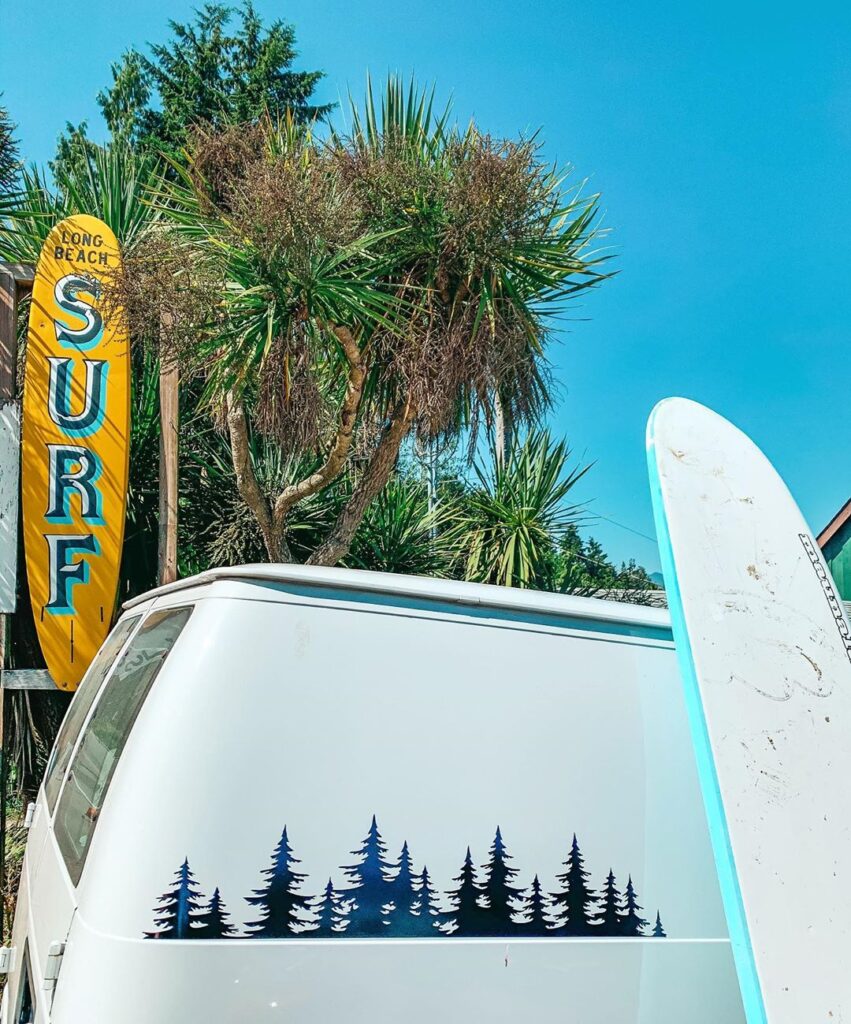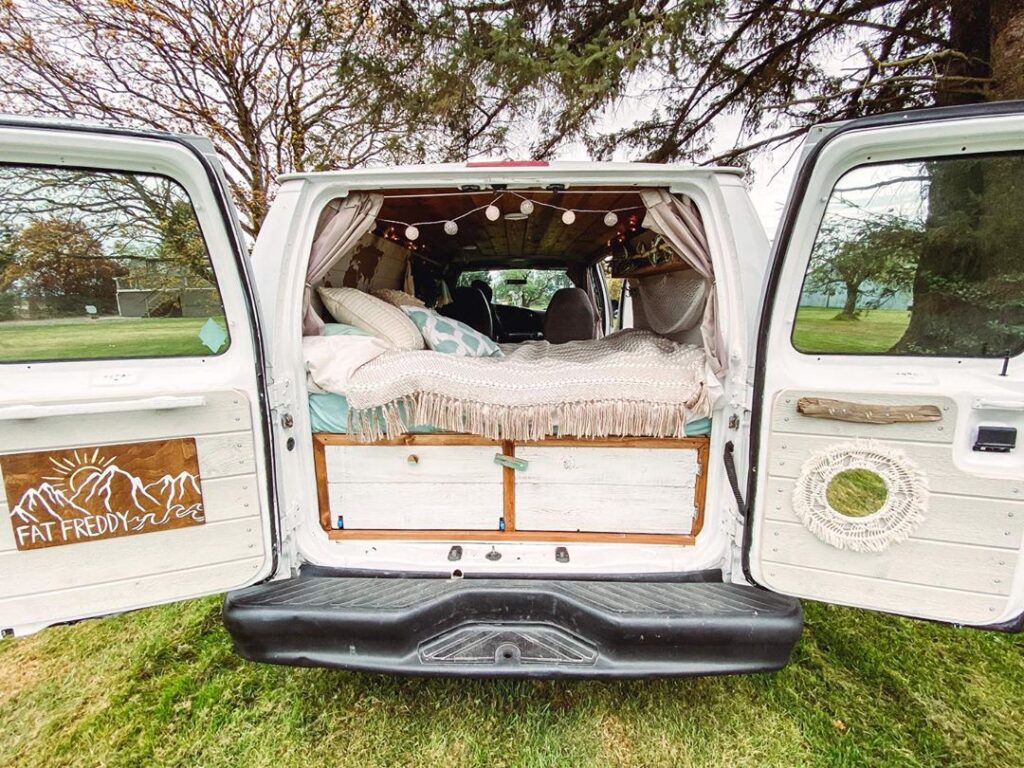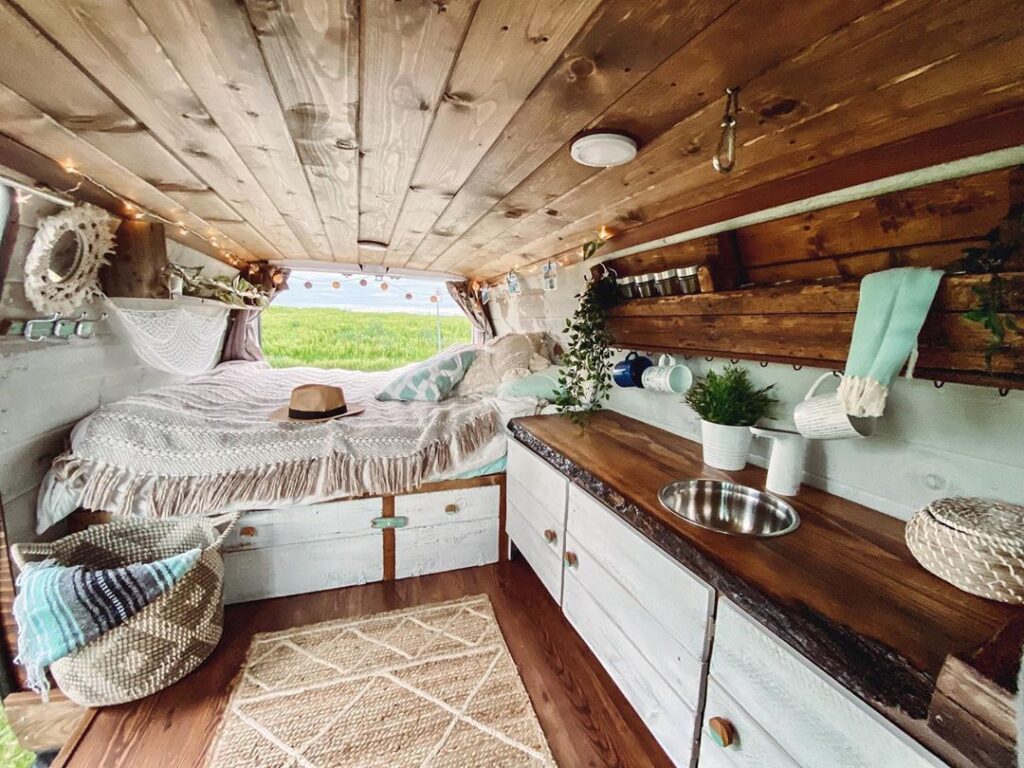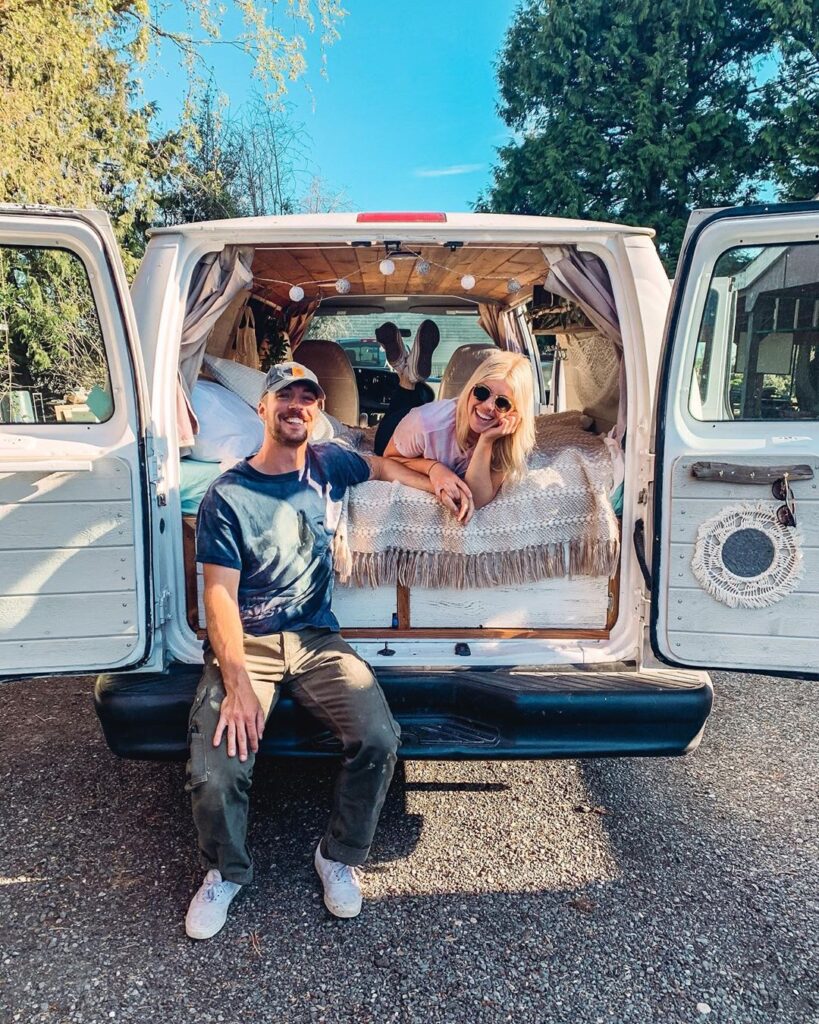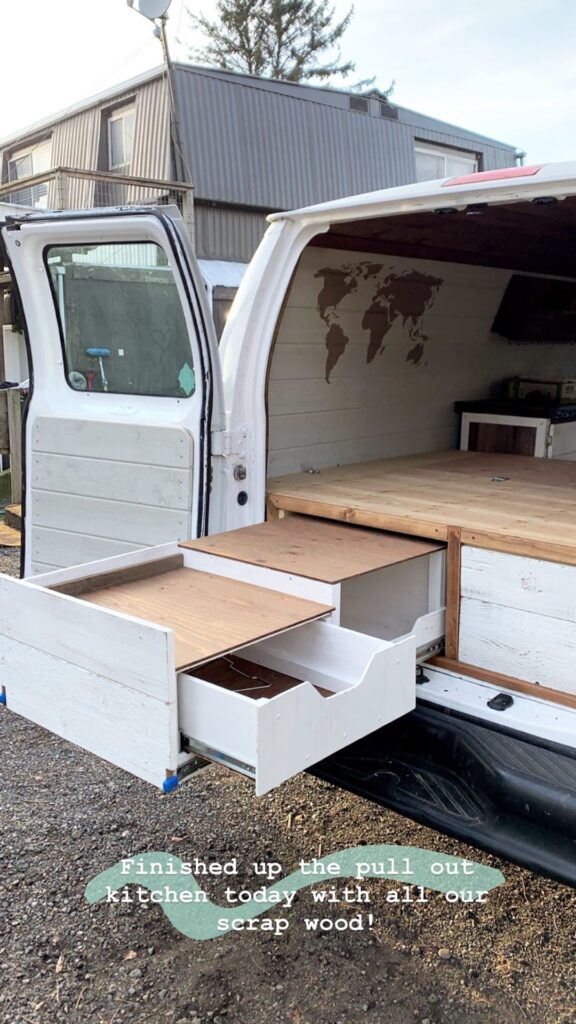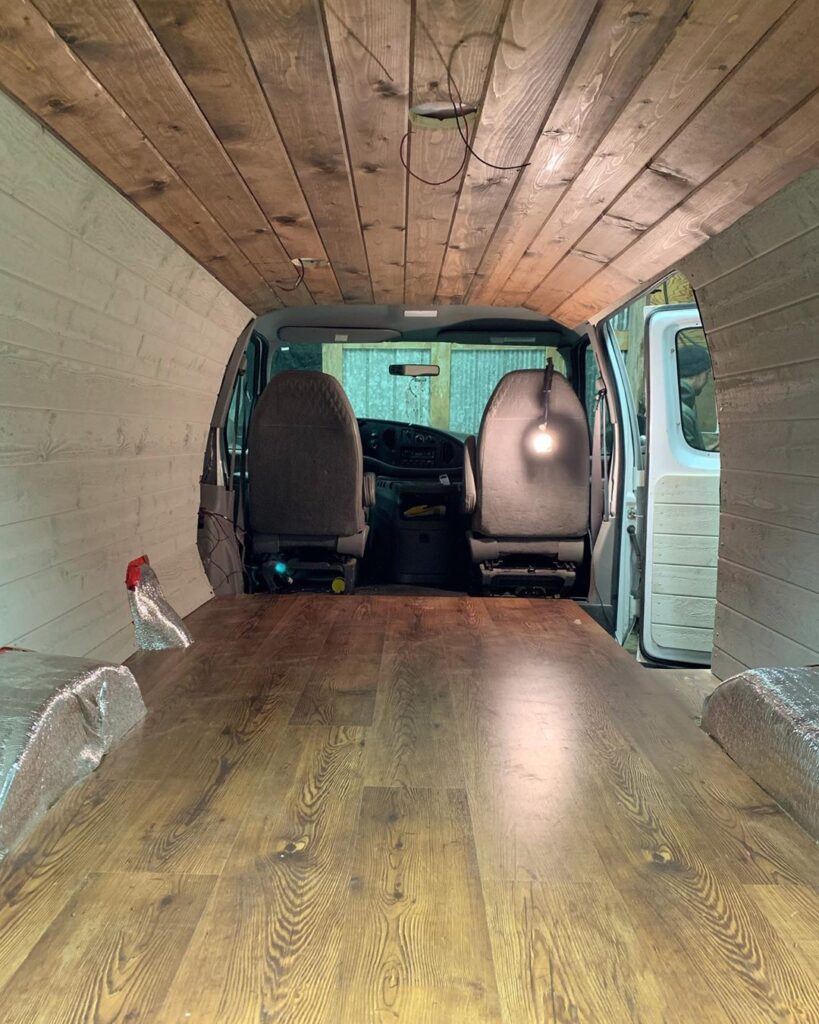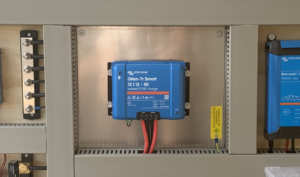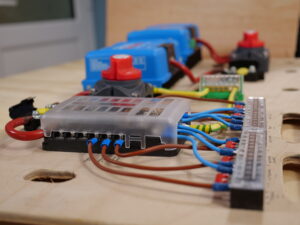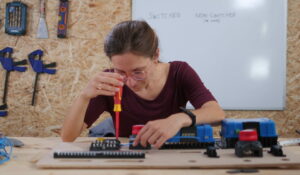Clayton and Alyssa’s Self-Converted 2002 Ford E150 Econoline
last updated: Dec 15, 2021
When you’re choosing to live off-grid in a van, it’s tempting to assume that bigger is better. The bigger the van; the more space you’ll have and the more comfortable you’ll be. But if you’re on a tight budget, this is easier said than done. After all, large vans come with large price tags. Our next couple, Clayton and Alyssa, are here to show you that small cargo vans shouldn’t be underestimated.
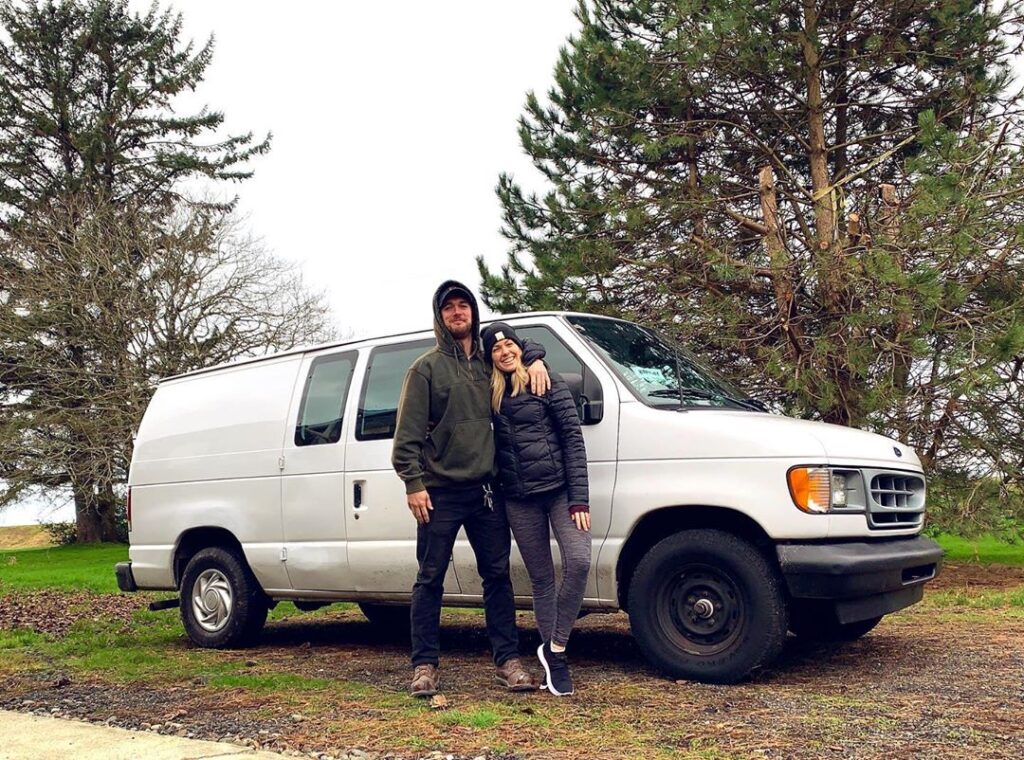
About Clayton and Alyssa
Clayton and Alyssa purchased their 2002 Ford E150 Econoline, Freddy, at the end of 2019. They’d been hunting for a cheap van with low mileage for quite some time, so when they first laid eyes on the Ford Econoline they knew it was fate.
But what drew them to van life in the first place?
Well, there are two main reasons. Firstly, they wanted a fun project that they could work on together. Alyssa is very creative and Clayton is very handy, so the project compliments both of their skillsets. Secondly, they both love nature and the outdoors. Having a van allows them to get up and go wherever they want, whenever they want.
After purchasing the van, the first thing they did was strip it clean. They wanted a fresh start, free from the influence of other people. When coming up with a van design, their main priorities were functionality, sustainability, and affordability. In other words, they wanted a bespoke van that was tailored to their needs but didn’t break the bank. From the floor to the shelves, you’ll notice that throughout the van Clayton and Alyssa have cut costs by repurposing scrap materials.
Due to monetary constraints, Freddy is very much a work-in-progress. The pair have no real regrets about how they built and designed their van, but there are a few things they’d like to improve. Most significantly, they plan to add a solar panel on the roof. This will provide the van with a self-sufficient source of electricity.
Specifications
- 2002 Ford E-150 Econoline– Choosing which van to purchase was a long process for Clayton and Alyssa, but they eventually settled on a 2002 Ford cargo van. Their decision ultimately came down to the fact that the van was cheap, has low mileage, and is good with fuel.
Kitchen and Appliances
- Salad bowl sink– Due to economic and logistical constraints, the pair decided to repurpose a salad bowl for their kitchen sink. To do this, they drilled a plug hole into the bottom of the bowl and connected a wastewater tank.
- Tap – Above the salad bowl sink is a stainless steel tap, which they purchased from Amazon. It is connected to a tank of clean water, located in the cupboard under the sink. The tap is rechargeable and typically lasts around 40 days. It can be charged with a simple USB plug.
- Primus gas stove– Located at the back of the van in their pull-out kitchen is a Primus gas stove, which Clayton and Alyssa use for cooking. When designing the kitchen space, they bought the stove first and shaped the rest of the kitchen around it. The stove is recessed downwards slightly so that the surrounding cupboards act as a wind-block, preventing the flame from blowing out.
Sleeping
- Fixed queen-sized bed– The pair opted for a fixed bed, which takes up a large proportion of space at the back of their van. In order to maximise their space, the bed lifts up to provide better access to the storage cupboards underneath.
Power and Electrical
- Fairy lights– Dotted along the wall around the bedroom area, Alyssa fixed some string lights. Their van doesn’t have electricity (yet) so the battery-operated lights are essential in the evenings when the sun has set.
Heating and Cooling
- Insulated walls, floor, and ceiling– Clayton and Alyssa knew that they’d want to go on adventures in both hot and cold climates. So it was important to equip their van for all eventualities. After purchasing and stripping their van, they lined the walls, floor, and ceiling with insulation. This helps to minimise draughts and reduce heat loss.
Cabinetry and Finishes
- Tongue-and-groove cladding– To line the inside walls of their van, Clayton and Alyssa opted for tongue-and-groove wood panelling. Not only did it fit with their vision, it was also relatively inexpensive.
- Wooden flooring– Throughout their van, the pair tried to recycle and repurpose as much as possible. Their wooden floor, for example, is made from scrap wood that they found in their barn.
- Wooden pallet shelf– Whilst driving around their neighbourhood one day, Clayton and Alyssa spotted a wooden pallet sitting in a dumpster. They decided to salvage the wood and use it to make a shelf. To do this they sanded it down, stained it and added hooks to hang their mugs.
- Driftwood shelf – Adjacent to the pallet shelf is another shelf, this time made from scrap driftwood that they found in their barn. This shelf is used to store the clothes they wear regularly.
- Cedar countertop– Their kitchen countertop is made from a piece of milled cedar, sourced by Alyssa’s uncle. They sanded it, stained it, and then secured it in place. They preserved the raw edge to give it a rustic look.
- World map painting– To signify their love of travelling, Alyssa decorated the back of the van with a world map painting.
Water System
- 1 x Fresh water tank
- 1 x Grey water tank
Storage
- 1 x Chest of drawers
- Ottoman bed– Clayton and Alyssa have an ottoman bed, which means that it lifts up to reveal a storage cavity. Within this, they have drawers, cupboards and an empty space to store bigger possessions such as kayaks. The storage cavity can also be accessed via the back of the van.
- Coat rack– This is made from upcycled driftwood. This has been somewhat of a game-changer for the pair, and they believe that everyone needs a coat rack in their van. Generally speaking, coats take up so much space, so it’s handy to have a dedicated area just for coats.
Comfort
- Velcroed decorations– To prevent their possessions from flying around while on-the-move, Alyssa decided to attach Velcro to each object. This makes it easier for the pair to get up and go, without having to worry about tidying up.
Exterior
- Slide-out kitchen– Without a doubt the most unique feature of this van is the slide-out kitchen. Since they opted for a small cargo van, there is not enough room inside for a full kitchen suite. So to maximise their space, Clayton designed a kitchen that slides in and out of their ottoman bed cavity. So far it consists of a Primus stove and countertop space, but over time they may extend this.
- Slide-out dining table– Inside the ottoman cavity next to the slide-out kitchen is a piece of wood, which folds out into a dining table.
To watch the full tour of Clayton and Alyssa’s van, check out my YouTube channel:
Build your own adventure
The guide anyone can use to convert a van into a camper! With over $350 worth of savings inside
Do you want to live vanlife at zero cost?
Nate Murphy knows how to buy vans, convert them quickly and efficiently - use them for years - and then sell them for a profit. This can make vanlife not just free, but profitable!
He has successfully done this for years and he teaches his friends and students to do exactly the same. It is not obvious, but anyone can do it if they have the knowledge!
Join Nate at his free online training (running today) and he will teach you exactly how he does this!

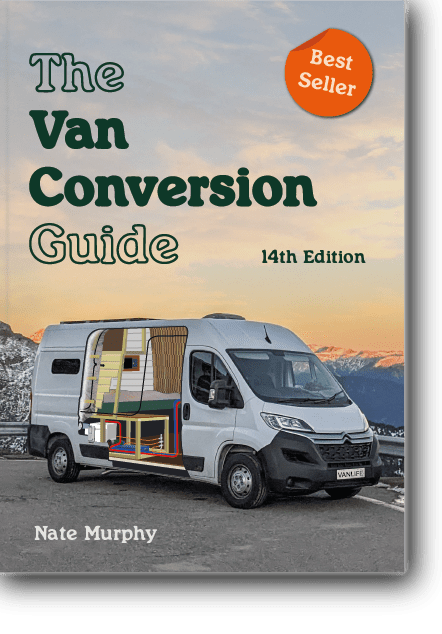
The Van Conversion Guide (14th Edition)
The guide anyone can use to convert a van into a camper! This best-selling guide, now in its 14th Edition, has been used by thousands of people to transform a van into a camper.
- 150+ page eBook
- Helps you convert any kind of van
- Diagrams for all the main systems
- FREE mini-course - 28 video tutorials
